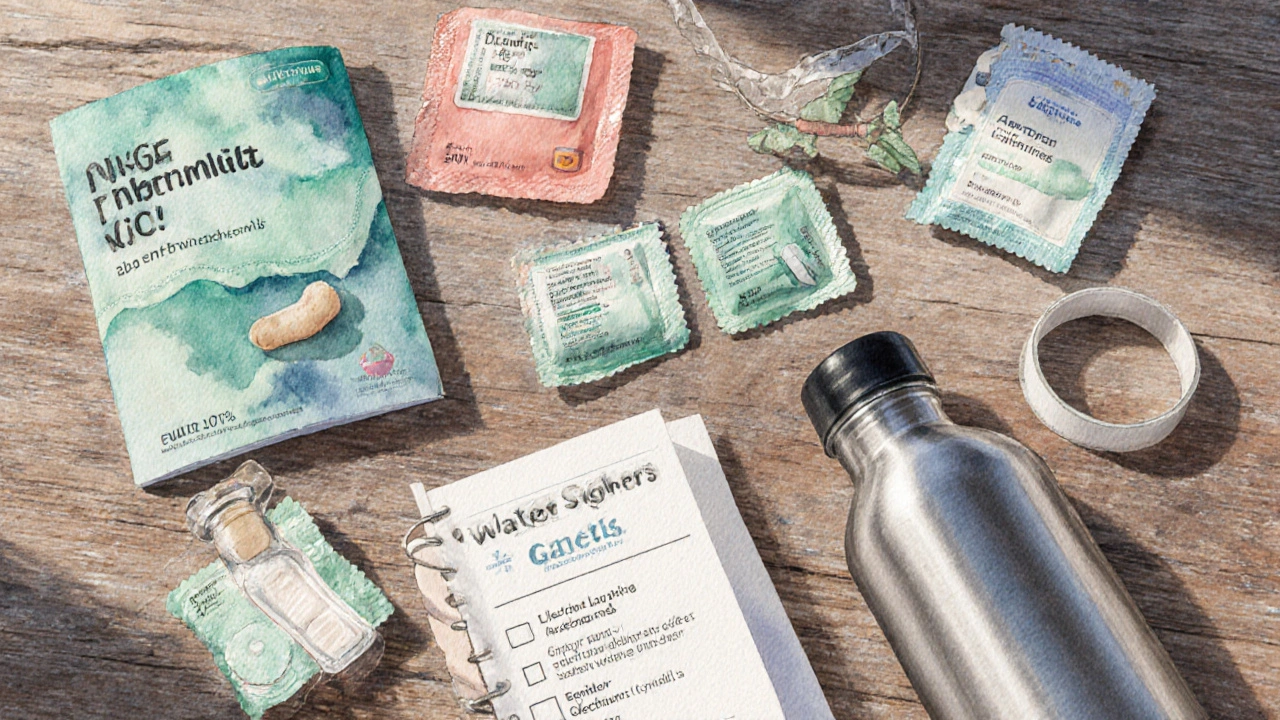Travel Sickness-Free Vacation: Step‑by‑Step Planning Guide
 Oct, 5 2025
Oct, 5 2025
Travel Sickness Prevention Planner
Your Personalized Travel Sickness Plan
When you dream about a beach sunrise or a mountain hike, the last thing you want is to spend the whole trip fighting travel sickness. Travel sickness is a catch‑all term for any nausea, dizziness, or vomiting that shows up while you’re on the move - whether you’re cruising on a ship, soaring above clouds, or winding through a winding road. Understanding how it works and planning ahead can turn a potential nightmare into a smooth, enjoyable getaway.
What Exactly Is Travel Sickness?
Motion sickness is the most common form of travel sickness. It happens when the brain receives conflicting signals from the inner ear, eyes, and deeper body sensors. The result? That classic feeling of queasiness and a desire to lie down.
Another frequent variant is seasickness, triggered by the rolling motion of watercraft. Though the underlying mechanism is the same as motion sickness, sea water can also cause dehydration, which amplifies symptoms.
Beyond the vestibular system, food‑borne bugs, jet lag, and even anxiety can contribute to a broader "travel‑related nausea" syndrome. Knowing which type you’re most prone to helps you choose the right countermeasures.
Pick the Right Prevention Strategy
There are three major buckets of prevention: pharmaceutical, natural, and behavioural. Below is a quick look at how they stack up.
| Approach | Typical Dosage | Onset | Side‑effects | Best For |
|---|---|---|---|---|
| Dimenhydrinate (e.g., Dramamine) | 50mg 30min before travel | 15‑30min | Drowsiness, dry mouth | Air and road trips up to 6h |
| Meclizine (e.g., Bonine) | 25mg 1h before travel | 1‑2h | Less drowsy, occasional blurred vision | Long‑haul flights & sea voyages |
| Promethazine (e.g., Phenergan) | 12.5mg 30min before travel | 30‑45min | Strong sedation, constipation | Severe cases, prescription only |
| Ginger root (capsules or candy) | 500‑1000mg 30min before travel | 45‑60min | Rare stomach upset | Light‑to‑moderate nausea, natural‑preferring travelers |
| Peppermint oil lozenges | One lozenge every 30min | 5‑10min | Possible heartburn | Quick relief on the go |
| Acupressure wrist band (P6 point) | Wear 30min before travel | Immediate | None | Non‑drug option, good for children |
Pharmaceuticals tend to be more predictable, but they can make you sleepy - not ideal if you want to explore right after landing. Natural options like ginger or peppermint are milder and work well for mild symptoms, but they may need higher doses for longer trips.
Behavioural tricks - sitting in the front seat of a car, focusing on the horizon, or keeping the head still - complement any chemical approach.

Design a Sickness‑Resistant Itinerary
- Choose flight times that match your natural sleep rhythm. Overnight flights often reduce motion‑related nausea because you’re already asleep.
- If you’re sailing, pick itineraries that avoid rough seas (check sea‑state forecasts). Early morning departures usually experience calmer waters.
- Include short “rest stops” every 2‑3hours on road trips. Stretching, fresh air, and a quick sip of water reset your vestibular system.
- When possible, schedule activities that keep you upright and distracted - like city tours or guided hikes - rather than long periods of sitting.
These planning tweaks don’t eliminate the cause, but they dramatically lower the chance of a full‑blown episode.
Pack Smart: The Essentials Kit
Your travel bag should have a dedicated antiemetic kit. Here’s a checklist that covers both medical and natural angles:
- Prescription or over‑the‑counter antiemetic medication (Dimenhydrinate, Meclizine, or Promethazine) - keep the original packaging for customs.
- Ginger capsules (500mg) or crystallized ginger - easy to swallow and mild on the stomach.
- Acupressure wrist bands - apply pressure to the P6 point on the inner forearm.
- Reusable water bottle - stay hydrated; dehydration worsens nausea.
- Electrolyte packets - especially useful on sea voyages where you may sweat more.
- Travel‑size hand sanitizer - reduces the risk of food‑borne illness.
- Compact snack bar (plain crackers or rice cakes) - helps settle the stomach if you feel queasy.
- Mini first‑aid guide that includes a quick‑relief flowchart.
Keep all meds in a waterproof pouch and store them where you can reach them quickly - a side pocket of your carry‑on is ideal.
Food & Water Safety - The Silent Triggers
Even if you beat motion‑induced nausea, a bad bite can ruin the whole trip. Follow these three rules:
- Drink safe water. In many regions, tap water contains parasites that cause gastro‑intestinal upset. Carry a portable UV purifier or use chlorine‑based tablets.
- Eat cooked, hot foods. Avoid raw salads, undercooked meat, or street‑vendor foods whose hygiene you can’t verify. Stick to freshly cooked meals that are served hot.
- Get the right vaccinations. For trips to tropical regions, vaccines against HepatitisA, Typhoid, and Cholera reduce the risk of severe stomach bugs. Consult a travel clinic at least 4weeks before departure.
Adding a travel insurance policy that covers medical evacuation and medication costs gives you a safety net if something slips through.

If Symptoms Strike: Rapid Response Plan
- Stop the motion. If you’re on a car, pull over. On a ship, move to a stable area near the centre of the vessel.
- Apply the 5‑minute rule. Sit upright, close your eyes, and breathe slowly for five breaths. This reduces vestibular overload.
- Take your chosen antiemetic. Follow the dosage on the label - most meds work within 30minutes.
- Hydrate gently. Sip water or an electrolyte solution; avoid carbonated drinks which can increase bloating.
- Use natural aids. Chew a small piece of ginger or pop a peppermint lozenge while you wait for the medication to kick in.
- Know when to seek help. If vomiting persists for more than 12hours, you develop a fever, or you notice blood, head to the nearest medical facility.
Having a ready‑to‑go symptoms sheet (printed or on your phone) speeds up decision‑making and reduces panic.
Checklist & Quick Reference
- Identify your primary trigger (motion, food, anxiety).
- Choose a prevention combo (e.g., Meclizine + ginger).
- Book flights that align with your sleep cycle.
- Pack antiemetic kit, hydration gear, and safe‑food guidelines.
- Verify vaccinations and travel insurance 1month ahead.
- Download a sea‑state or flight‑track app for real‑time conditions.
- Review the rapid response steps the night before departure.
Print this list, tick each box, and you’ll leave home feeling confident instead of anxious.
Frequently Asked Questions
Can I take motion‑sickness pills if I’m pregnant?
Most over‑the‑counter antiemetics (Dimenhydrinate, Meclizine) are classified as CategoryC, meaning risk cannot be ruled out. Always talk to your OB‑GYN first. Ginger in moderate doses is generally considered safe during pregnancy, but even that should be approved by your doctor.
Is there a difference between seasickness and motion sickness?
The physiological cause is the same - conflicting signals to your brain - but sea travel often adds dehydration and constant rolling, which can make symptoms feel stronger. That’s why electrolyte drinks and a waterproof medication pouch are extra important on boats.
How long before a flight should I take an antiemetic?
For Dimenhydrinate, 30minutes prior is ideal; Meclizine works best when taken 1hour before travel. If you’re on a long‑haul flight, a second dose mid‑flight (per package instructions) can keep you comfortable.
Do acupressure wrist bands actually work?
Studies show a statistically significant reduction in nausea for up to 60% of users, especially when combined with other methods. They’re drug‑free, cheap, and have no side‑effects, making them a solid backup.
What should I do if I get food‑borne diarrhea abroad?
Stop eating solid foods for a few hours, sip oral rehydration salts or a sports drink, and consider an over‑the‑counter loperamide if diarrhea is severe. If you develop a fever, blood in stool, or symptoms last more than 48hours, seek medical care immediately.

Holly Hayes
October 5, 2025 AT 19:41Honestly, if you’re not packing ginger‑infused kombucha, you’re just flaunting your mediocre travel taste.
Matthew Shapiro
October 14, 2025 AT 08:08When planning a trip, it helps to align the timing of any anti‑emetic with the expected onset of motion. For example, Dimenhydrinate works best about thirty minutes before boarding, while Meclizine benefits from an hour’s lead time. Pairing the medication with a simple ginger capsule can smooth out residual nausea.
Julia Phillips
October 22, 2025 AT 20:34Imagine stepping onto a sunrise‑lit deck, the sea calm and your stomach steady – that’s the magic of preparation. A wristband pressed on the P6 point while you sip a ginger‑tonic can turn a potential seasick nightmare into a serene voyage. Even the most seasoned sailors swear by the combination of acupressure and a splash of peppermint oil.
Richa Punyani
October 31, 2025 AT 09:01Esteemed travelers, may I emphasize the virtue of structured itineraries. By incorporating brief interludes-stretching, hydration, and horizon‑gazing-you fortify your vestibular equilibrium. Such disciplined pauses are the hallmark of a journey unmarred by malaise.
Bhupendra Darji
November 8, 2025 AT 21:28Don’t forget to stash a waterproof pouch for your meds; a quick grab can save the day.
Robert Keter
November 17, 2025 AT 09:54First, understand that motion sickness stems from a discord between visual cues and inner‑ear signals, a phenomenon well documented in neurophysiology literature; this discord triggers the chemoreceptor trigger zone, precipitating nausea. Second, recognize that the severity of this response can be modulated by both pharmacologic and non‑pharmacologic interventions, each with distinct pharmacokinetic profiles. Third, select a medication whose half‑life aligns with your travel duration-Dimenhydrinate for short hops, Meclizine for transcontinental flights, or Promethazine when symptoms are severe and warrant a more potent antihistamine effect. Fourth, supplement any drug regimen with ginger or peppermint, as studies have shown that 500‑1000 mg of ginger can reduce nausea intensity by up to 40 % in controlled trials, while peppermint oil lozenges provide rapid, localized relief through menthol’s soothing action on the gastrointestinal mucosa. Fifth, incorporate behavioral strategies such as front‑seat positioning in vehicles and horizon fixation, which have been shown to lower vestibular conflict by up to 30 % in real‑world settings. Sixth, stay adequately hydrated; dehydration amplifies vestibular sensitivity, so aim for 250 ml of water every hour, supplemented with electrolyte solutions on marine voyages. Seventh, pack a compact “anti‑emetic kit” that includes a prescription container, ginger capsules, acupressure wristbands, and a reusable water bottle-organizing these items in a side pocket of your carry‑on ensures immediate access. Eighth, consider the temporal aspect of medication dosing: for Dimenhydrinate, a 30‑minute pre‑flight window is optimal, whereas Meclizine requires a full hour to achieve peak plasma concentration. Ninth, anticipate compound effects; if you combine medication with ginger, monitor for any additive drowsiness, especially when operating a vehicle post‑arrival. Tenth, be prepared for contingencies: if vomiting persists beyond twelve hours, or if you develop fever, seek medical care promptly, as prolonged emesis can lead to electrolyte imbalance and dehydration. Eleventh, remember that food‑borne pathogens can masquerade as motion‑induced nausea, so always consume well‑cooked, hot meals and use a portable UV water purifier when local water safety is uncertain. Twelfth, schedule vaccinations appropriate to your destination well in advance, as infections such as typhoid or hepatitis A can compound gastrointestinal distress. Thirteenth, maintain a mental checklist-a printed or digital copy of your anti‑emetic plan-so you can execute it without panic. Fourteenth, leverage technology: flight‑track or sea‑state apps provide real‑time data, allowing you to anticipate turbulence or rough seas and adjust your strategy accordingly. Fifteenth, after arrival, give your body a gentle re‑adjustment period; avoid heavy meals and intense physical activity for the first few hours. Sixteenth, finally, celebrate your proactive preparation, for a journey free of nausea is not merely a matter of luck but of diligent planning and evidence‑based choices.
Rory Martin
November 25, 2025 AT 22:21While the guide seems thorough, I can’t help but notice the omission of any discussion about government‑mandated micro‑chips in anti‑emetic pills. Those little implants could be tracking our every queasy moment.
Maddie Wagner
December 4, 2025 AT 10:48Friends, your health is priceless-think of your travel plan as a partnership between you and your body. Embrace the combo of medication, ginger, and mindful breathing, and you’ll walk away feeling triumphant, not queasy.